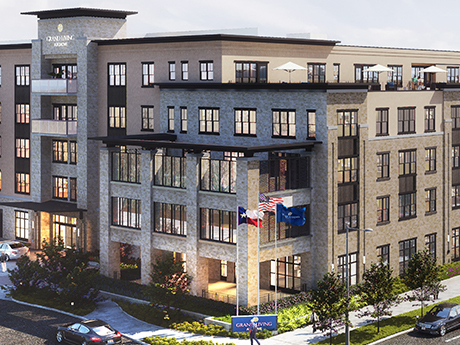By Jane Adler
Post-pandemic, senior living owners and operators are rightfully focused on regaining occupancy and stabilizing their assets. Expansion opportunities have mostly been limited to acquisitions of troubled properties purchased at a discount. Inflation, relatively high interest rates, a tight labor market and even tighter capital markets have largely sidelined ground-up development.
But contrarian players believe now is the right time to build. Much of the existing stock of seniors housing is 20-plus years old, and baby boomers are just over the horizon. A development that breaks ground today will be ready to welcome the first wave of boomers who turn 80 in two years. New projects will face less competition too because of today’s difficult development environment.
“This is the perfect time to put a shovel in the ground,” says Anders Pesavento, senior vice president of capital markets at Ryan Cos. The Minneapolis-based development and investment firm has four seniors housing projects slated to break ground this year that are valued at approximately $385 million.
The lack of new supply and strong demand supports the case for building now, emphasizes Pesavento. “We believe we will be rewarded.”
The volume of seniors housing units under construction is at its lowest level since 2015, according to the first-quarter 2024 report by Raleigh-based NIC MAP Vision. The number of units under way in the top 31 markets identified by NIC stood at less than 30,000 units in the first quarter. Independent living and assisted living units comprised about half of the new construction underway.
Assisted living units under construction totaled 4.4 percent of the existing inventory, well below the peak of 10.2 percent in 2017. Independent living units under construction totaled 4 percent of the existing inventory, down from the peak of 6.6 percent in mid-2019.
At the end of 2023, the Pacific region represented 19 percent of the total units under construction in the 99 NIC MAP primary and secondary markets. The Mid-Atlantic and Southeast regions accounted for 19 percent and 17 percent of the total units under construction, respectively.
NIC MAP Vision tracks 750 active adult rental properties totaling roughly 111,000 units. No construction data is available, though new projects are ramping up as the product gains consumer acceptance. The penetration rate, which compares the inventory of active adult units to households age 65 and older, is less than 1 percent.
The inventory of assisted and independent living is expected to increase by 4.1 percent, or 44,000 units, by 2026, according to an April 2024 report by Omar Zahraoui, principal at the National Investment Center for Seniors Housing & Care (NIC), headquartered in Annapolis, Maryland. That represents half to one-third of the projected demand growth.
At the end of the report, Zahraoui asks: “Will seniors housing stakeholders capitalize on these trends and proactively prepare for the future, or will they maintain a passive wait-and-see stance?”
‘Not For The Faint of Heart’
Developers with access to capital and a long-term view of the market are seizing the opportunity. “We like to build when other people are not,” says Andy Kohlberg, president and CEO of Carlsbad, California-based Kisco Senior Living. In 2021, the company entered into a partnership with healthcare REIT Welltower to develop new projects.
But new development in today’s environment takes persistence and a bit of creativity. “This is not for the faint of heart,” says Patricia Will, founder and CEO at Belmont Village Senior Living headquartered in Houston.
Will adds that the company has grown organically by building in select markets. It is currently focused on South Florida and coastal Southern California, two markets with attractive demographics and high incomes.
Belmont Village owns and operates 36 senior living communities across the country, offering independent and assisted living and memory care.
In January 2024, Belmont Village broke ground on a new project in Aventura, its third project in South Florida. Belmont Village Coral Gables opened last November. Belmont Village Fort Lauderdale opened in 2021 during the pandemic.
Belmont Village has a project under way in San Ramon, California, near San Francisco. The company also recently announced a new project in Rancho Santa Fe, California, in partnership with Greystar Real Estate Partners, which is based in Charleston, South Carolina. Another Belmont Village project is planned for Palm Beach County, Florida.
“It takes a long time to find the right site, get it entitled and develop the project,” says Will. “We are patient.”
For example, the Fort Lauderdale project sits on a desirable spot in a dense neighborhood. The site was originally a parking lot for a retail center. So, Belmont moved the parking for the retail center to its new building. “You have to do something unusual to access the real estate,” says Will.
Overbuilt markets can still hold opportunity. “We look for the hole in the donut,” says Pesavento at Ryan Cos. “This is a retail-driven asset class. We look for a specific corner in a specific market,” he says. But he admits that gaining control of the right site and putting all the other development pieces into place is quite a challenge today.
Less Competition
Kisco prefers upscale markets with high barriers to entry — places where it is hard to find a quality site, secure entitlements and build. “The combination of a difficult market and difficult financing makes it hard for other developers to come in,” says Kohlberg.

The Fitzgerald at Palisades, a project in Washington, D.C., by Kisco Senior Living, opens later this year. The property is part of Signature, Kisco’s luxury brand.
Kisco owns and operates 32 communities, including those from its recent acquisition of Balfour Senior Living. The communities are mostly a combination of independent and assisted living, and memory care.
The company has three new projects opening soon. Two are in the Washington, D.C., area and a third is near Boston. The three communities are part of the company’s signature collection, a high-end brand launched about a year ago.
Kisco also has three new communities in the planning stages in The Woodlands, Texas, north of Houston; Summerlin, near Las Vegas; and Columbia, Maryland. The projects should open in two to four years, according to Kohlberg, hitting the market at an opportune time.
Developers are also building active adult projects. Big players include multifamily developers such as Greystar and Troy, New York-based United Group of Cos. Active adult rents are about 40 percent lower than independent living, but 20 percent higher than multifamily rents. That makes active adult projects an attractive investment, sources say.
Columbus, Ohio-based Treplus Communities has five active adult projects in the Buckeye State and another under way. A typical community features 120 single-story units. Jane Arthur Roslovic, co-founder and CEO of Treplus, noted at a recent industry conference that municipalities are becoming increasingly difficult to work with, an observation echoed by other developers.
Show Me The Money
Financing new projects is a huge hurdle. Developers that have established relationships with capital partners, such as REITs, are moving forward with new projects. For example, Treplus partners with Welltower.
Belmont Village partners with Harrison Street, a Chicago-based private equity firm. In a twist, Belmont’s capital partner for its Coral Gables project is Baptist Health South Florida. The
232-unit building, which offers independent living, assisted living and memory care services, includes a retail store on the ground floor. Residents also have onsite access to the Baptist Health system. “Leasing has broken all records for Belmont Village,” says Will.
Construction loans are still scarce, but there are signs that could be changing, sources say.
“In the last 90 days, we’re seeing more movement from banks than we’ve seen in the last three years,” says Chris Hoard, co-founder, president and chief development officer at Distinctive Living Development, based in Freehold, New Jersey. “Banks are opening back up.” He adds that banks prefer working with developers that they’ve worked with before. “Relationships are everything,” he says.
Distinctive Living operates 50 properties in 11 states. The company has 12 new projects in active development and several others in its pipeline. Four of the projects are active adult communities — three in New Jersey and one in North Carolina. Hoard hopes to break ground on two of the New Jersey projects in late 2024 or early 2025. He also expects rising construction prices to ease by then (see sidebar on page 20).
Though debt is hard to secure, developers say equity partners can be even more difficult to find. “Limited partners are a big challenge,” says Hoard. Private equity firms are more active investors today, he adds.
Pesavento at Ryan Cos. agrees that equity is the more challenging piece of the capital stack. He thinks equity sources are hesitant to invest for three reasons.
First, there’s great uncertainty over whether the Federal Reserve will cut the benchmark federal funds rate and when that might occur. The target range of the federal funds rate, which influences credit card and mortgage rates, currently stands at 5.25 to 5.5 percent.
Second, equity sources have less capital to recycle because they’re focused on improving net operating income in their existing portfolios.
Third, equity sources are also waiting to snag underperforming properties at prices that are below replacement costs in order to realize outsized returns. But Pesavento says that scenario doesn’t always materialize since banks generally don’t want to foreclose on senior living properties. The banks would rather work with the borrower to restructure the loan.
Bond financing for nonprofit projects is available for qualified sponsors. “If organizations are looking to expand or build a new campus, they can’t wait,” says Chuck Murphy, senior managing director of development at Des Moines-based LCS Development. Once the capital markets ease up, nonprofits could face more competition from for-profit providers, which all jump back into the development market at the same time, he adds.
For example, LCS Development recently finished Broadview at Purchase College, a life plan community located on the campus of Purchase College in Westchester, New York. Life Care Services, an LCS company, provides management services.
LCS also develops and owns for-profit senior living projects. The company recently opened two projects under the Delaney brand in Woburn, Massachusetts and Florham Park, New Jersey. Both projects were financed before the pandemic when capital was more available, says Murphy.
When will the Federal Reserve lower interest rates and spark more development? The see-saw of inflation rates —appearing to ease in one government report and ramp up in the next — makes it especially difficult to predict.
“Who knows if they’re going to drop interest rates, but they’re not going to drop them a lot this year,” says Murphy. He adds that LCS takes a long-term view of the market. “We aren’t here to build something and sell it. We think that positions us better to serve our residents.”
— This article originally appeared in the May-June 2024 issue of Seniors Housing Business magazine.


